
Kansas Joe McCoy and Memphis Minnie: “When the Levee Breaks” (1929)
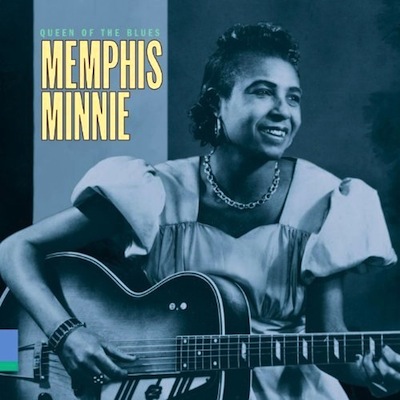
The infosphere is fairly crackling with the news that the current incarnation of the musical ensemble Fairport Convention Fleetwood Mac has notified one of its elderly members that his services will not be required for their upcoming world tour. More than 40 years later, Fleetwood Mac Drama still grabs headlines.
My favorite story about Fleetwood Mac is that during the Narcissistically tumultuous (my words, not theirs) recording of their 1977 mega-album Rumours, the two remaining founding members of the band (Mick Fleetwood and John McVie) repaired to the recording studio’s parking lot to get a breath of fresh air. One of these two gentlemen, not at all at peace with the way things were then developing (at the time, the tattered remnants of the original band were being either re-energized or supplanted by a pair of newcomers), said (or perhaps it is more accurate to write, “whined”) to the other,
“You know, we used to be a blues band.”
To which the other replied, “Yeah. But now, we’re rich.”
(That riposte refers to the fact that while the group was recording Rumours, their most-recently-released recording Fleetwood Mac, which was the first album with newcomers Lindsey Buckingham and Stevie Nicks, was topping the charts and already throwing off so much cash that the previously hardscrabble members of the band were buying houses in Los Angeles. But: A blues record, Fleetwood Mac was not.)
That exchange says a lot about the endgame of British popular music’s fascination with American blues music.
Intriguing history, and sound bytes, after the jump link. Continue Reading →
Stile Antico: De Victoria, Tenebrae Responsories for Holy Week
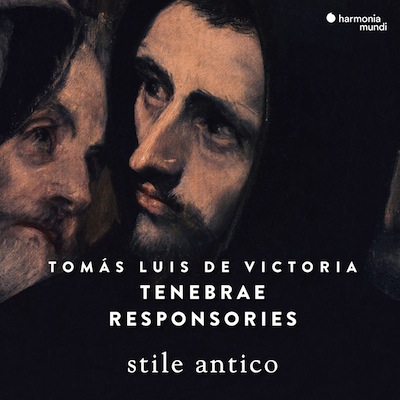
Stile Antico:
Tomás Luis de Victoria, Tenebrae Responsories for Holy Week
CD Harmonia Mundi HMM 902272
Downloads (24-bit/88kHz AIFF, ALAC, FLAC, and WAV stereo) available from HDTracks.
Streaming available from Tidal and Apple Music.
Recorded at All Hallows’ Church, Gospel Oak (North London) England, February 13-17, 2017. Robina G. Young, producer; Brad Michel, engineer.
The British early-music group that calls itself “Stile Antico” once again proves that they are, without doubt, one of the most impressive vocal ensembles before the public today. I Imagine that their group name just might be a bit of an insider’s joke—stile antico is a musical term used (from the early 1600s on) to characterize the continued creation of new but historically-conscious “old style” music.
The composers of stile antico music declined to embrace the emerging Baroque stylistic trends of increasingly elaborate ornamentation and more complex (and freer) counterpoint. Stile antico composers regarded the works of older composers (especially Palestrina) as ideals that could not be surpassed—a position that was still being put forward (believe it or not) even as late as the 1870s (at least in the realm of sacred music)… .
The group Stile Antico’s “Unique Selling Proposition” is that they work without a conductor or music director, in this regard being more like a chamber-music instrumental ensemble than an orchestra. While this might seem a very daunting prospect, I think that with so much of the repertory being four-part scores (two high voices and two low voices), hashing things out should be no more difficult than, say, when a string quartet’s members decide among themselves how a movement (such as the slow movement of Beethoven’s op. 127) should be played. (Irony alert.)
I was rather agog at Stile Antico’s 2006 début SACD Music for Compline when I wrote about it for Stereophile magazine, and they have continued at that high level for more than 10 years. Their articulation, phrasing, and ensemble work are among the best; but what really sets them apart is the lush richness of their vocal sound. Arkivmusic.com has Stile Antico’s Music for Compline on offer at $9.99, which I gather is a 10th-anniversary non-SACD CD reissue. That one’s a no-brainer. Just buy it. The o.o.p. SACD version is available from third-party sellers on Amazon, at prices ranging from market-correct to delusional. (But I did tell Stereophile‘s readers to just buy that, more than 10 years ago.)
After the jump: a making-of video of Stile Antico’s Tenebrae Responsories, some background and commentary, and a few sound bytes. Continue Reading →
A Classical-Music Record Producer Remembers…
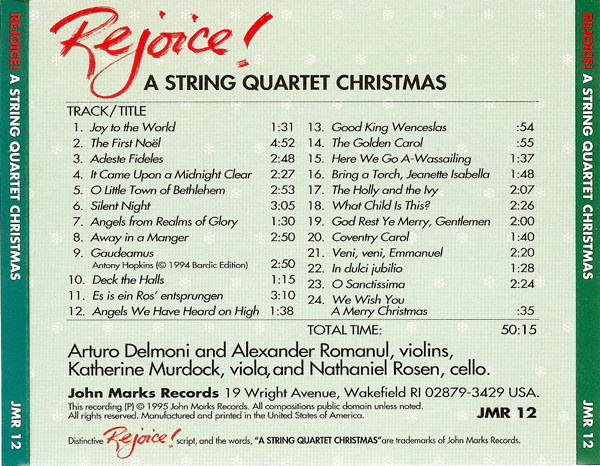 (The copyright date is 1995, despite the release date having been late 1994.)
(The copyright date is 1995, despite the release date having been late 1994.)
Last week marked Arturo Delmoni’s 70th birthday. We met in 1980 through mutual friends, during the summer music festival at Rhode Island College. At the time, I was both a budding audiophile (the term was not much in use back then) and also, since my junior-high-school days, an audio-video nerd. Years before, an uncle had given me an open-reel tape recorder he was no longer using. I recorded my junior-high-school chorus in lamentable stuff such as, “If We Could Talk to the Animals” from Doctor Doolittle. (That was a 1967 film that Rex Harrison most likely did not have to live very long after, in order to regret muchly. Sigh.)
Customers of my parents’ delicatessen-café included the couple who ran the independent record label SQN (or Sine Qua Non). I chatted them up about their possibly releasing a recording to be funded and owned by Arturo Delmoni and licensed to them. The one good thing that SQN did for me (well, over and above giving me an “education” in how the music business really works) was to introduce me to engineer David Hancock.
The SQN folks recommended David Hancock because he had not yet invested in the latest digital-recording technology, and therefore his rates were lower than those of the top guys. David had invested, however, in a spanking-new Studer A80 analog tape machine, set up to use half-inch two-track analog tape running at 30 inches per second. Whew.
Now, class, a “thought experiment.”
How many people today would pay over $300 for a sealed-copy LP of Songs My Mother Taught Me, if it had been recorded using early-generation digital technology??? (It is said, that to state some propositions is to refute them.) David Hancock was also a fan of Charles Fisher’s C35 Cambridge microphones, which were, in essence, improved RCA model 44 ribbon microphones with an active proximity-effect-compensation circuit. Those were the microphones David had used on his legendary 1967 recording of Donald Johanos and the Dallas Symphony in Rachmaninoff’s Symphonic Dances.
Dawn on the Mississippi River (New Orleans, March 5, 2018)

Photograph © 2018 John Marks
I don’t have a “Bucket List.”
That said, if I did, watching the sun rise over the Mississippi River in New Orleans would be a good thing to add to such a list. For some reason, the view made me think of Mussorgsky’s “Dawn on the Moskva River,” from his rarely-performed opera Khovanshchina.
(The link is to a very evocative YouTube slideshow over a USSR Symphony Orchestra performance with Evgeny Svetlanov, conductor.)
# # #
Vox Luminis: “Mille regretz” (attr. Josquin des Prez, c. 1450/1455 – 1521)
If humans were like amoebas—and multiplied by dividing—nobody (with the potential exception of Sarah McLachlan) would write songs about lost love. The song sub-genre “Baby, This Makes Me So Blue” predates the 1950s… by about 500 years. The chanson “Mille regretz” (“A Thousand Regrets”) is usually attributed to Josquin des Prez, who flourished in the late 1400s and early 1500s–the High Renaissance. Josquin was his name, and polyphony was his game.
“Mille regretz” was reputedly the favorite song of King Charles I of Spain, who in due course became Holy Roman Emperor Charles V. Charles’ consolidated holdings stretched from Peru to Bohemia, totaling about 1.5 million square miles. His was the first empire about which it was said, the sun never set upon it. But even he got the blues; and when he did, he turned to music. Continue Reading →
Hyperion Knight at the Alexander Piano
What is it about Australians, New Zealanders and Tasmanians and grand pianos??? At the ripe age of 15 years, Adrian Mann asked his piano teacher how long a piano bass string would have to be, not to require a copper wire over-wrap (to add mass, and thereby lower the resonant frequency). Her answer was, “Very long.” Over the next several years, young Adrian taught himself to build a piano almost entirely from scratch; the result is nearly 19 feet long. He is now doing business under the name Alexander Piano. Hyperion Knight was on tour in that part of the world, and so he stopped in, with the above result. There are two other Hyperion K. videos on Alexander Piano’s YouTube page.
# # #
Glenn Gould: Richard Strauss, “Morgen” op. 27, no. 4 (solo-piano excerpt)
In terms of cultural impact in the broadest sense, Glenn Gould (1932-1982) was one of the most important musicians of the 20th century.
Susan Sontag once quipped that every analogy is a lie, so: you have been warned. I think that Glenn Gould’s place in classical music in the mid-twentieth century is analogous to Miles Davis’ place in jazz during that same era. If people owned only one real jazz LP, it likely was Kind of Blue; and if people owned only one real classical LP, it likely was Gould’s J.S. Bach Goldberg Variations. Gould, more than any other pianist, is associated with the Goldberg Variations, to the extent that the opening measures of the “Aria” are carved on his gravestone.
Unlike most classical pianists of the time, Gould largely ignored the 19th-c. Romantic piano repertory exemplified by Chopin and Liszt, concentrating instead on Renaissance and Baroque music. Gould brought early music before the general public at a time when it was almost exclusively the province of academic specialists, or performers on period-correct instruments. In 1956, Gould’s intuitive understanding of Bach’s style of counterpoint, and his unprecedented clarity of articulation on the grand piano fell like a thunderclap, upon critics and the listening public alike. (Gould’s first Goldbergs album was recorded in 1955, but released in 1956.) Gould’s 1955 Goldbergs remain one of the best-selling non-crossover classical recordings of all time.
What Gould revered in Bach was his sense of sonic architecture. I think that the heart of Bach’s art was that Bach created ordered musical structures to reflect the nature of a God who had created an ordered cosmos that was (largely) comprehensible by the use of reason. (Yes; I know. I am painting with a brush so broad that it can’t fit into a one-gallon paint can.) Therefore, it might not come as a total surprise that in this video clip from a television interview, Gould takes Richard Strauss to task for his Romantic self-indulgence. Or, does he really?
More wild guessing from John, and sound bytes from different performances of Richard Strauss’ early song “Morgen,” after the jump. Continue Reading →
Pianist Hyperion Knight to Perform in Providence (RI), February 25, 2018
Audio by Jerry Bruck, Posthorn Recordings NYC; video and editing by John Marks
I will return to my former avocation of concert impressario, and present audiophile-fave-rave pianist Hyperion Knight in a program of Bach, Beethoven, and Gershwin at the First Baptist Church in America, in Providence (RI) on Sunday, February 25 at 2:00 PM. The recital will be open to the public, and free of charge.
The Third Meeting House of the First Baptist Church in America is a short (seven minutes) walk from the Providence Amtrak (train) station. The starting time of the recital was chosen to make it possible for music lovers from New York City to Boston to arrive and depart with the least fuss possible.
The program consists of music of J.S. Bach (selected Inventions; and transcriptions of choral and organ music including the “Little” Fugue in g); Beethoven’s piano sonata no. 21 in C, “Waldstein”; and Gershwin’s Suite from Porgy and Bess. The recital will last approximately one hour, and will proceed without an intermission. Continue Reading →
Schola Sanctæ Sunnivæ: Chant from the Fingergull Manuscript
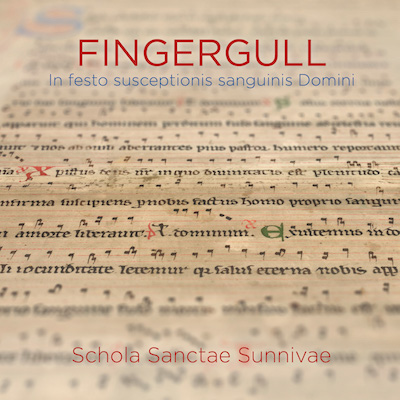
Schola Sanctæ Sunnivæ:
FINGERGULL – In festo susceptionis sanguinis Domini
SACD/CD 2L-114-SACD
Downloads (MP3 stereo; CDQ FLAC stereo; high-resolution stereo including
MQA, DXD PCM, and DSD; and 5.1 surround-sound) available from www.2L.no
Streaming available from Tidal and Spotify.
Recorded at Ringsaker Church, Norway, May 2014. Prof. Eugeen Liven d’Abelardo, producer and musical advisor; Beatrice Johannessen, recording engineer; Morten Lindberg, mastering engineer.
Christianity was the original “New Age” movement. Because of that, perhaps the easiest way for most listeners to take in this extraordinary recording of an a-cappella female vocal ensemble chanting music from a 13th-century parchment manuscript might be to think of it as “New Age Music,” and then just leave it at that.
I hereby give you permission to ignore the specific historical context of this music, and to concentrate on letting the enveloping and consoling, nearly weightless clarity of the unison female voices wash over you.
I would expect that within minutes, you might begin to feel yourself transported—if not to a higher realm, then at least to a safe and quiet place… perhaps to a medieval church rather like the one where this remarkable recording was made.
For many years, I would say about such a recording, “Just buy it.” And for many listeners, that still makes the most sense, in that this release is a compatible hybrid multichannel SACD, and furthermore, there are high-resolution downloads available for purchase. But I recognize that many music lovers now rely upon a streaming service as their major source of new music, so I am glad to report that this recording can be heard via on-demand streaming from Tidal and also Spotify.
Session photo, sound samples, and more, after the jump link. Continue Reading →
“They were so young and happy and beautiful… “
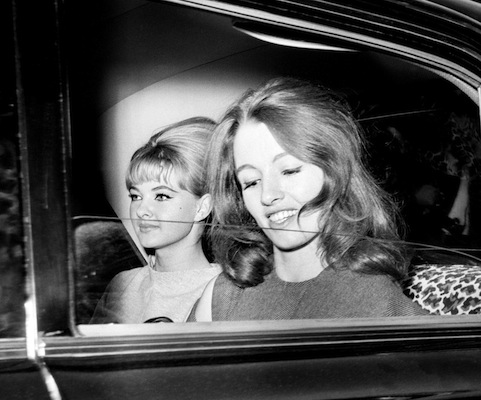
I am fascinated and at times a bit awed by… connections. My brief but meaningful interaction with film-score composer John Williams means that through him, I am one handshake away from Marilyn Monroe; that’s because John Williams was the rehearsal pianist for the songs Marilyn Monroe sang for the soundtrack of Some Like It Hot. Through Stéphane Grappelli, I am one handshake away from… Django Rheinhardt. Through Yehudi Menuhin, I am one handshake away from: Elgar, Bartók, Ysaÿe, Enescu, Busch, and Bruno Walter. And countless others. Through engineer and Mahler expert Jerry Bruck, I am one handshake away from Alma Mahler (Gropius Werfel); and therefore, two handshakes away from Gustav Mahler.
The concept of connections, for me at least, dovetails with what I call the “Horseshoe-Nail Theory of History.” That’s the idea, enshrined in the proverb-poem “For Want of a Nail,” that an overlooked small difference in initial conditions can lead to a specifically-unforeseen “failure cascade” that has immense consequences. I wrote about the Horseshoe-Nail theory of history for The Truth About Cars. That blog entry, “Horseshoe Nails, The Rhythm of History, and General Motors,” argues that the late-1950s decision by General Motors not to spend five dollars per car to fix the dangerous handling of the first-generation Chevrolet Corvair ultimately led (in 2000) to the election of George W. Bush as the President of the United States.
After the jump link, I identify the two pretties in the photo above, and explain their impact on history, and their connection to me. Continue Reading →


